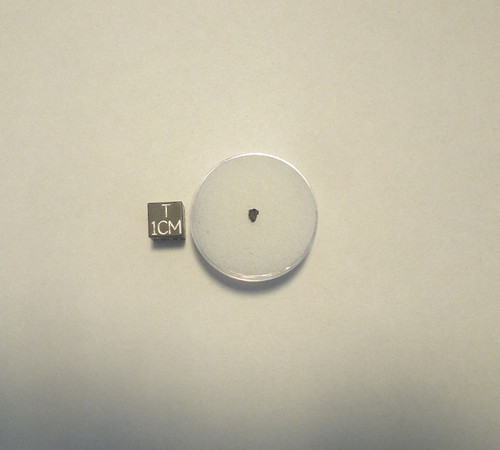In the early evening hours of November 20, 2008, a brilliant fireball lit up the skies over Saskatchewan Canada. Thousands of witnesses saw the bright bolide and it was captured on many cameras around the area. The fireball was extremely bright and it made objects cast shadows on the darkened ground. There were also many reports of sonic phenomena, including explosions and buzzing sounds. The fall became an immediate media sensation and with news networks around the world reporting on it. This was one of the first examples in modern times of a meteorite fall going "viral" and capturing mainstream media attention. Every collector should have an example of this famous meteorite.
Meteorite hunters found many stones and later analysis revealed them to be H4 chondrites. The largest recovered mass was approximately 13 kilograms.
Refer to the photo. The black centimeter cube is shown for scale and is not included. You are purchasing a small fragment like the one shown. Your purchase will include a labeled gemjar for safe storage.
From the Meteoritical Bulletin entry on Buzzard Coulee :
Buzzard Coulee 52°59.76′N, 109°50.89′W
Wilton Rural Municipality, Saskatchewan, Canada
Fall: 20 November 2008; 17:26:45 MST (UT + 7)
Ordinary chondrite (H4)
History: A bright fireball was widely observed across Alberta, Saskatchewan and Manitoba during late twilight on November 20, 2008. The fireball and subsequent dust trail, or shadows cast by the fireball, were recorded by all-sky and security video cameras establishing that its brightest portion occurred from 17:26:40 to 17:26:45 MST. The fireball traveled approximately north to south with an elevation angle of ~60°. Abundant sonic phenomena were reported including anomalous sounds, explosion booms, sonic booms from individual fragments and whirring sounds interpreted as produced by individual fragments falling to ground; the fireball’s explosions were also widely recorded by Comprehensive Test Ban Treaty infrasound stations establishing an energy release of approximately one third of a kiloton, indicating an original meteoroid mass of ~10 tons. Interviews of eyewitnesses and crude calibrations of security cameras constrained the fall region and the first search attempt led to meteorites being recovered off the ice of a manmade pond late on November 27, 2008. Subsequent searches led to recovery of more than one hundred individual fragments before December 6 when increasing snow cover made further searching unproductive. A strewn field at least seven kilometers long and approximately three km wide with a wind drift tail of an additional three km eastwards has been crudely outlined.
Physical characteristics: A total of 129 well-substantiated pieces totaling ~41 kg have been recovered, but dozens of additional recovered specimens are indicated. The meteorites are distinguished by the large number of specimens with immature ablation surfaces (angular shapes with numerous small piezoglypts); up-range in the strewn field a larger proportion of mature ablation surfaces and oriented individuals are found. The fusion crust is a typical dark gray for an ordinary chondrite fall. The fall is also distinguished by the large proportion of meteorites that exhibit freshly broken surfaces with no fusion crust; broken surfaces with variable amounts of “painting” by fusion crust are also common.
Petrography (M. Hutson and A. Ruzicka, Cascadia; E. Milley and A. Hildebrand, UCalg): Most surfaces show no brecciation, but one surface has a slightly lighter gray angular clast in a uniform gray matrix. Two different chondrite textures are visible in one thin section, but boundaries between the two regions are indistinct. One area has welldefined chondrules. The other region has more opaques with fewer easily visible chondrules, but has numerous smaller cryptocrystalline chondrules and chondrule fragments. Another section contains a light colored, coarse grained, pyroxene-rich inclusion with an igneous texture.
Classification: Ordinary chondrite (H4), S2, W0.





